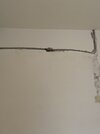- Joined
- 7 Nov 2021
- Messages
- 6
- Reaction score
- 0
- Country

Hi,
I’ve had some work completed by a builder recently including moving a light switch. The wiring has been spliced and then covered with electrical tape, to then be plastered over.
I have a couple of questions:
1. Does the wiring look ok?
2. How should the wiring be plastered over?
Thanks
I’ve had some work completed by a builder recently including moving a light switch. The wiring has been spliced and then covered with electrical tape, to then be plastered over.
I have a couple of questions:
1. Does the wiring look ok?
2. How should the wiring be plastered over?
Thanks

